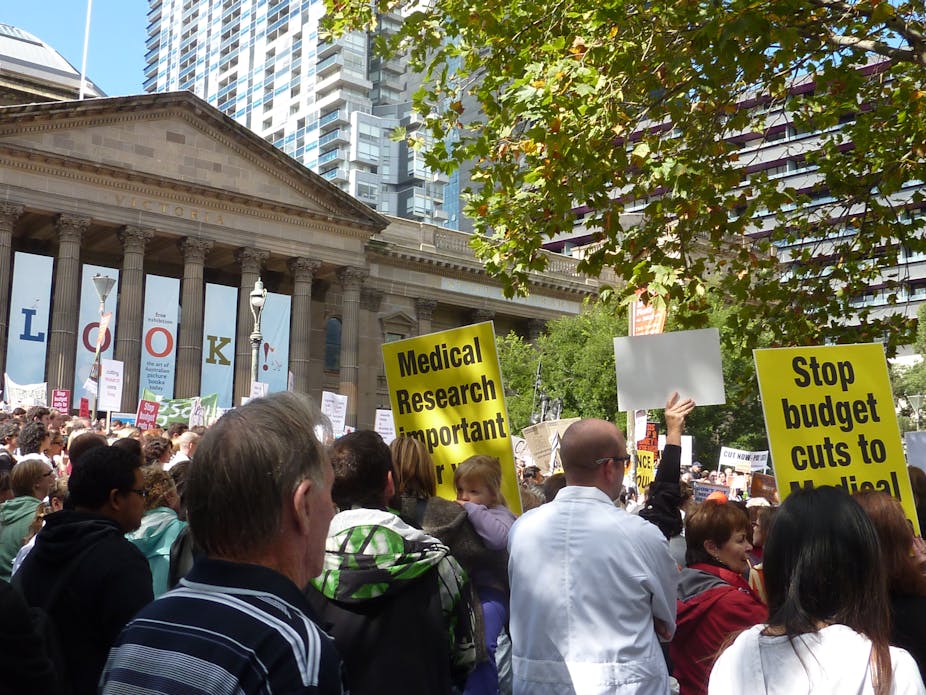Recent rumours from the highest levels of the Commonwealth Government indicate the National Health and Medical Research Council’s (NHMRC) budget may be slashed by $400 million over the next three years.
Cabinet is yet to make a final decision but if the Government were to make the cut, the consequences for Australia’s health and medical research sector would be dire.
In 2010, the NHMRC provided $710 million worth of grants for a wide range of activities. The figure included funding for over 4,179 new and continuing grants.
Normally applications for funding for a three-year research project have a 22% to 25% success rate. If the cuts in funding go ahead as suggested, this could reduce that success rate to less than 10%.
This would have devastating consequences for young scientists at the early stages of their career as well as for established investigator teams.
In addition, around $157 million of the $710 million is distributed to established researchers for career award fellowships; for research training fellowships, nationally and overseas; and career development awards for clinician-scientists.
Cuts of $400 million over three years would decimate these programs and destroy the chances of NHMRC-funded triumphs in Australian discoveries.
For example, the discovery and subsequent development and commercialisation of the cochlear implant for profoundly deaf children and adults was funded by project and program grant funds from the NHMRC.
This implant is a world leader, a testament to the quality of the science behind it and its leadership by Professor Graeme Clark AC.
The discovery of GM-CSF (Granulocyte-macrophage colony-stimulating factor) by Professor Don Metcalf AC and his team at The Walter and Eliza Hall Institute (WEHI) that Amgen now commercialise for treating patients undergoing chemotherapy for cancer would not have been possible without NHMRC funding to WEHI researchers.
The cervical cancer vaccine developed by Professor Ian Fraser and his team owes much to NHMRC support in its early discovery phase.
There are many more examples of world-class, ground-breaking Australian medical research but the critical message is simple: Australia must nurture a significant body of world-leading medical scientists to do two things.
First, to develop competence to transfer discoveries made internationally into the Australian context. Australia contributes between 4% and 5% of all innovation in health (well above its pro rata population contribution of 2%) and we have a ready health research workforce with international links that is competent enough to assess risk and translate treatments.
Second, Australia must invest in “creative minds”. By this I mean we must provide support for and nurture the careers of medical researchers. Whether they are clinician scientists or basic scientists, both are essential for the discovery – translation pipeline that gives significant cost-benefit returns to our health dollar.
My own career illustrates this importance of this support.
I was fortunate to be awarded a CJ Martin NHMRC Training Scholarship for two years in an overseas laboratory and a third year of support to establish my career back in Australia.
I joined Professor James Black FRS, OM at University College, London in 1978 after he had discovered a β-adrenoceptor antagonist propranolol for hypertension and other cardio-vascular diseases and the H2-recepter antagonist cimetidine for gastric ulcer. He won the Nobel Prize for the latter in 1988.
I owe my career to this initial overseas training fellowship and subsequent NHMRC support through the career fellowship scheme while I worked as a research fellow at The Baker Medical Research Institute, with promotion to Senior Principal Research Fellow.
I cannot imagine how Australia - in the midst of a mining boom - could possibly consider it prudent to cut investment in those bright minds who have chosen a research career.
The rewards in research are to discover something new, apply it to key problem areas and translate the knowledge learnt here and overseas for the benefit of all.
The NHMRC makes a strategic, relatively small investment in our best minds. To do less or cut the existing funding will lose a whole generation of young scientists. It could herald the start of a brain drain.
An NHMRC research funding cut would be like eating the seed corn - future generations of Australians will judge this government harshly for it.
Read more on the proposed NHMRC funding cuts:
Gentlemen’s rules are out, scientists: it’s time to unleash the beast

